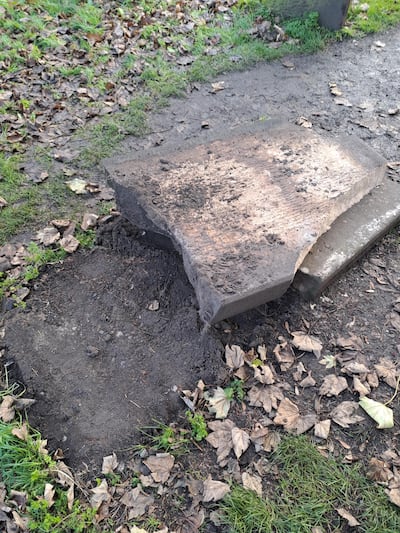Shrewsbury in Shropshire may be one of the handsomest towns in England but last weekend it fell victim to an ugly form of vandalism that is on the rise in Britain: the damaging of historic tourist attractions.
Ebenezer Scrooge was the cranky, fictional anti-hero of Charles Dickens’s 1843 seasonal tale A Christmas Carol. The popular 1984 film version of the story, starring Hollywood actor George C Scott, was filmed in Shrewsbury, a town bestowed with a surfeit of Tudor and Georgian elegance.
One of the best-loved scenes in the story is when the Ghost of Christmas Yet to Come hauls the miserable old Scrooge to a cemetery to see the grave of a man who was disliked by his neighbours. Scrooge wipes the snow from the headstone’s inscription to reveal that it is, of course, his own grave, which cracks to a clap of thunder.
That famous scene was filmed in the yard of St Chad’s, a late 18th century church with a huge circular nave that lies on the outskirts of the town centre. The film-makers took an old headstone from the churchyard with a weathered inscription that could no longer be seen and chiselled Ebenezer Scrooge’s name on to it, along with a huge crack across the middle.
READ MORE

Last weekend it was broken for real by vandals who invaded St Chad’s churchyard and smashed the Scrooge headstone to pieces. The fictional grave was left in place by the filmmakers and grew to become one of the main tourist sites in Shrewsbury. Dickens was closely associated with the town and performed readings from A Christmas Carol at a hotel on Wyle Cop, a local thoroughfare. The link with the story became part of Shrewsbury’s identity, especially at this time of year.
“It’s one of those things that is very dear to everybody’s hearts,” Helen Ball, the town clerk, told BBC Radio Shropshire this week. “A lot of us go on a Christmas pilgrimage to see it, [and] whenever we have any friends or family who come to stay we always make a point of taking them to it.”
Referring to the reaction to the vandalism in Shrewsbury, she said: “When you look at the Facebook messages people put [up] yesterday it’s united a community in disgust that somebody can do that.”
The incident in Shrewsbury is part of an unfortunate trend in Britain. A report earlier this year from heritage watchdog Historic England showed that vandalism of heritage and tourist sites is on the rise and now presents a “significant threat”, especially to old churches with valuable stone.
Just this month vandals attacked a locally-beloved statue in Edwinstowe, a Nottinghamshire village on the edge of Sherwood Forest. The statue depicted Robin Hood proposing to Maid Marian. Vandals ripped the couple’s arms off. Residents quoted in local newspaper reports simply couldn’t understand it.
Last week two youths scaled the top of the 800-year old round tower at Dolbadarn Castle, an iconic sight at the base of Yr Wyddfa, a Welsh mountain also known as Snowdon. The youths wielded hammers and also threw ancient blocks to the ground below. Police, who caught one of the vandals, described the damage as “unbelievable”. The act of destruction was videoed and went viral on social media.
The 12th century Aberdeenshire Huntly Castle, the ancestral home of the Gordon clan, was also vandalised this month. In August it was the turn of the 13th century Kilwinning Abbey on Scotland’s coast southwest of Glasgow. One of its 13th century piers was bludgeoned to rubble. Meanwhile, Anglican churches in the north of England are reeling from a spate of thefts of valuable York Stone, stripped from their walls and pathways. Eight churches were attacked earlier this year in just a few nights in Cheshire and Lancashire. Historic England says this type of crime is rising by 10 per cent annually.
As attacks on Britain’s national heritage these incidents all pale in the shadow of the felling of the ancient tree at Sycamore Gap at Hadrian’s Wall in Northumberland. It stunned the nation when news broke of its destruction last September.
Yet each of the incidents is a local tragedy. In Shrewsbury Martin Wood, the seven foot tall town crier, brought tourists to the Scrooge grave. He was also the body double for the hooded ghost in the filming of the spooky scene in 1984, the same year he became town crier. Now he and the rest of Shrewsbury must lament the wanton destruction of one of the town’s most beloved emblems.


















